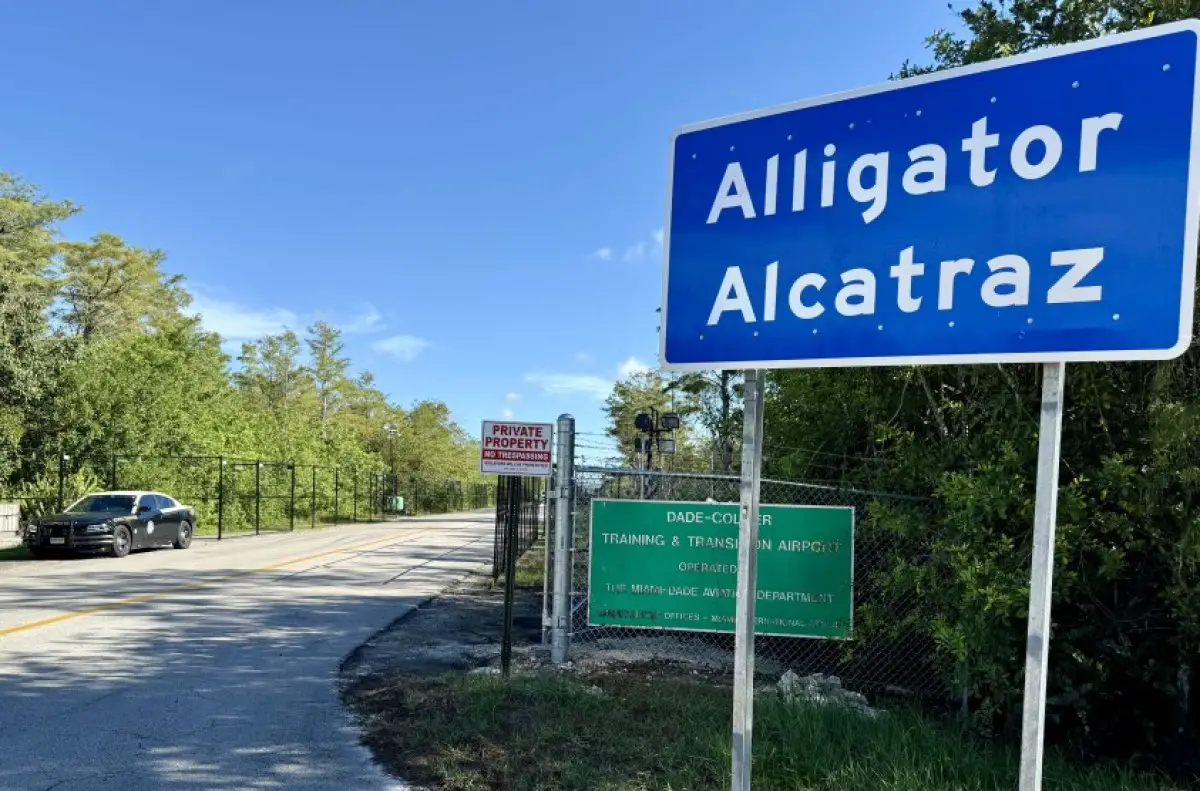A brewing constitutional crisis has erupted between state and federal authorities over a controversial detention facility that has become a symbol of the complex intersection between immigration enforcement, environmental protection, and federalism in modern America. The dispute, which pits gubernatorial authority against federal judicial power, threatens to escalate into one of the most significant state-federal confrontations of the immigration enforcement era while raising fundamental questions about the balance between security priorities and environmental stewardship.
The Judicial Intervention: An 82-Page Environmental Mandate
U.S. District Judge Kathleen Williams, an Obama appointee, delivered what amounts to a comprehensive dismantling order for the facility known as “Alligator Alcatraz” through an extensive 82-page ruling that cited multiple environmental statutes and constitutional concerns. The decision represents far more than a simple closure order, requiring the complete removal of industrial infrastructure within a 60-day timeline that officials describe as operationally impossible and politically motivated.
Williams’ ruling specifically invoked the National Environmental Policy Act (NEPA), a foundational environmental law that requires federal agencies to assess the environmental impacts of their actions before implementation. Her decision found that the facility’s construction and operation violated NEPA requirements by failing to adequately consider environmental consequences before beginning operations.
The judge’s environmental analysis focused particularly on habitat destruction and threats to endangered species, with specific emphasis on the Florida panther, a critically endangered subspecies whose population numbers fewer than 200 individuals statewide. Williams wrote that the facility “creates irreparable harm in the form of habitat loss and increased mortality to endangered species in the area,” establishing environmental damage as the primary legal justification for immediate closure.
The scope of the dismantling order proves particularly comprehensive, requiring removal of industrial lighting systems, perimeter fencing, electrical generators, sewage treatment facilities, and other infrastructure components that represent millions of dollars in state investment. This extensive removal requirement suggests the judge viewed the facility’s environmental impact as so severe that partial mitigation measures would prove inadequate.
The 60-day timeline for complete dismantling adds urgency that state officials characterize as unrealistic and potentially dangerous, given the need to relocate approximately 400 current detainees while maintaining security protocols and ensuring compliance with federal detention standards.
DeSantis’ Defiant Response: Anticipation and Resistance Strategy
Governor Ron DeSantis’ response to the federal court order demonstrates a carefully planned resistance strategy that suggests his administration anticipated judicial intervention and prepared contingency measures to maintain immigration enforcement operations despite federal court opposition. His characterization of Judge Williams as an “activist judge” reflects a broader Republican narrative about federal judicial overreach in immigration matters.
“This was not something that was unexpected. This is a judge that was not going to give us a fair shake. This was preordained. Very much an activist judge that is trying to do policy from the bench,” DeSantis declared at a press conference, framing the dispute in terms of judicial activism rather than legitimate environmental concerns.
The governor’s prepared response suggests sophisticated legal and political strategy development that extends beyond reactive crisis management to encompass proactive planning for federal resistance. His immediate announcement of alternative detention capacity indicates that the administration developed backup plans specifically designed to circumvent potential federal judicial intervention.
DeSantis’ rhetoric also positions the conflict within broader themes of federal overreach and state sovereignty that resonate with conservative political bases while potentially laying groundwork for appeals court challenges and Supreme Court review. His characterization of the ruling as “preordained” suggests confidence in appellate review and ultimate vindication of state authority.
The governor’s emphasis on continued deportation operations despite judicial intervention demonstrates commitment to immigration enforcement priorities that transcend individual facility operations, suggesting that the “Alligator Alcatraz” controversy represents just one component of a broader state-federal confrontation over immigration policy implementation.
The “Deportation Depot”: Expansion Amid Legal Challenge
DeSantis’ announcement of a second detention facility, dubbed the “Deportation Depot,” represents a dramatic escalation of state immigration enforcement infrastructure that directly challenges federal attempts to limit such operations through judicial intervention. The facility’s planned location north of Jacksonville in Baker County suggests strategic positioning designed to maximize operational efficiency while potentially avoiding some environmental concerns that affected the Ochopee location.
The new facility’s projected capacity of 2,000 detainees would more than quintuple current detention capacity, representing a massive expansion of state immigration enforcement capabilities that could position Florida as the primary hub for southeastern regional deportation operations. This scale of expansion suggests ambitions that extend far beyond state-specific immigration enforcement to encompass broader regional and national detention operations.
The governor’s emphasis on the facility’s proximity to airport infrastructure highlights the operational advantages intended to streamline the deportation process from initial detention through final removal. This integrated approach to detention and removal operations demonstrates sophisticated planning designed to maximize efficiency while minimizing opportunities for federal intervention or legal challenges.
The “Deportation Depot” designation itself reflects the administration’s communication strategy, using memorable branding that emphasizes the facility’s primary purpose while potentially appealing to political supporters who favor aggressive immigration enforcement. This naming approach suggests confidence in public support for expanded detention operations despite federal judicial opposition.
Environmental Groups and Tribal Opposition: The Miccosukee Challenge
The legal challenge that prompted Judge Williams’ ruling originated from a coalition of environmental groups and the Miccosukee Tribe, whose opposition combines environmental protection concerns with tribal sovereignty and cultural preservation issues. The tribe’s involvement adds complexity to the legal and political dynamics by invoking federal obligations to protect tribal interests and treaty rights.
The Miccosukee Tribe’s traditional connection to Everglades ecosystems provides them with unique standing to challenge development projects that threaten environmental integrity in areas of cultural and spiritual significance. Their legal participation transforms the dispute from a simple state-federal conflict to encompass tribal sovereignty and environmental justice dimensions that complicate political messaging and legal strategy.
Environmental groups supporting the challenge argue that the detention facility’s location within sensitive Everglades ecosystem areas poses irreversible threats to endangered species and critical habitat areas that justify immediate closure regardless of immigration enforcement priorities. This argument positions environmental protection as a non-negotiable priority that supersedes immigration enforcement considerations.
The coalition’s success in obtaining comprehensive judicial relief demonstrates the effectiveness of combining environmental law with tribal sovereignty claims in challenging state immigration enforcement infrastructure. This legal strategy could provide a template for similar challenges to detention facilities in other environmentally sensitive areas.
Federal-State Tensions: Constitutional Federalism Questions
The confrontation between DeSantis and federal judicial authority raises fundamental questions about the constitutional balance between state and federal power in immigration enforcement, particularly when state operations conflict with federal environmental regulations and judicial oversight. This tension reflects broader debates about cooperative federalism and the limits of state authority in traditionally federal policy areas.
The dispute highlights complex questions about which level of government possesses ultimate authority over immigration detention operations, particularly when state facilities support federal deportation efforts while potentially violating federal environmental laws. This jurisdictional complexity creates opportunities for conflicting legal interpretations and institutional competition.
DeSantis’ defiance of federal court orders also raises potential constitutional crisis scenarios if state officials refuse to comply with federal judicial mandates, creating enforcement challenges that could require federal intervention or Supreme Court resolution. Such escalation could transform the dispute from a policy disagreement into a fundamental constitutional confrontation.
The broader implications extend beyond immigration policy to encompass questions about federal judicial authority over state operations and the mechanisms available for enforcing federal court orders against resistant state governments. These questions have historical precedents in civil rights enforcement but represent novel challenges in immigration context.
The Trump Administration Context: Federal-State Cooperation
The dispute occurs within the broader context of renewed federal-state cooperation on immigration enforcement under the Trump administration, which has encouraged state participation in deportation operations while potentially creating conflicts with other federal priorities like environmental protection. This cooperation represents a significant shift from previous federal approaches that sought to limit state immigration enforcement activities.
The Trump administration’s support for expanded state detention capacity creates potential conflicts within federal government priorities when state operations violate federal environmental laws or trigger federal judicial intervention. These internal federal conflicts complicate resolution strategies and create opportunities for continued institutional tension.
Federal immigration officials’ support for the Florida facility demonstrates the administration’s willingness to prioritize immigration enforcement over environmental compliance, potentially creating precedents for similar conflicts in other states with aggressive immigration enforcement programs.
Legal Strategy and Appeals Process
DeSantis’ legal team appears prepared for extended appellate litigation that could ultimately reach the Supreme Court, suggesting confidence in legal arguments about state authority and federal judicial overreach. The administration’s characterization of Judge Williams as an “activist judge” provides political messaging that could influence appellate review and public opinion.
The appeals process will likely focus on questions about NEPA applicability to state-operated facilities supporting federal immigration enforcement, the scope of federal judicial authority over state detention operations, and the balance between immigration enforcement priorities and environmental protection requirements.
State officials’ emphasis on the facility’s previous use and existing development suggests legal arguments about the environmental impact assessment requirements and whether NEPA review should apply to expansion of existing operations rather than completely new development.
The timeline for appeals and potential emergency stays creates urgency that could influence judicial decision-making and the scope of interim relief available to state officials seeking to maintain operations pending final resolution.
Economic and Operational Implications
The forced closure and dismantling of “Alligator Alcatraz” represents significant financial costs for Florida taxpayers, including both the initial investment in facility infrastructure and the expenses associated with compliance with the dismantling order. These costs add political dimensions to the legal dispute by creating concrete taxpayer impacts.
The operational disruption caused by facility closure affects not only the 400 current detainees who must be relocated but also the broader immigration enforcement infrastructure that depends on adequate detention capacity to support deportation operations. These disruptions could affect federal immigration enforcement effectiveness throughout the southeastern region.
The economic implications extend beyond immediate closure costs to encompass potential liability for environmental remediation and restoration activities that could prove far more expensive than initial facility construction and operation costs.
Long-term Political and Policy Implications
The resolution of this dispute will likely influence future state immigration enforcement initiatives and federal environmental oversight of such operations, potentially establishing precedents that affect similar conflicts in other states. The outcome could either validate aggressive state immigration enforcement or strengthen federal environmental oversight authority.
The political implications extend beyond Florida to encompass broader Republican messaging about federal overreach and Democratic responses about environmental protection and rule of law. The dispute provides both parties with opportunities to mobilize their respective political bases around core policy priorities.
The confrontation also highlights the complex relationship between immigration enforcement and environmental protection, two policy areas that rarely intersect but create novel legal and political challenges when they conflict.
As this constitutional showdown continues to unfold, it will test the boundaries of state authority, federal judicial power, and the balance between competing policy priorities in an increasingly polarized political environment. The ultimate resolution may depend not only on legal precedents and constitutional interpretation but also on political calculations and public opinion about the appropriate balance between immigration enforcement and environmental protection in American governance.

Adrian Hawthorne is a celebrated author and dedicated archivist who finds inspiration in the hidden stories of the past. Educated at Oxford, he now works at the National Archives, where preserving history fuels his evocative writing. Balancing archival precision with creative storytelling, Adrian founded the Hawthorne Institute of Literary Arts to mentor emerging writers and honor the timeless art of narrative.
